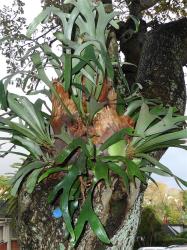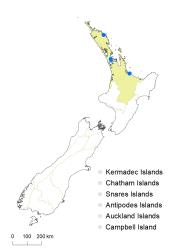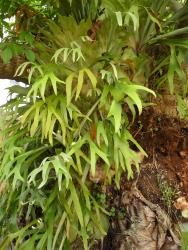- ≡ Acrostichum bifurcatum Cav., Anales Hist. Nat. 1: 105 (1799)
Platycerium bifurcatum is easily recognised by its perching, epiphytic habit and strongly dimorphic fronds, with sterile, appressed, orbicular to reniform, basal ‘nest’ fronds, and fertile, pendulous, dichotomously dividing, aerial fronds. The lamina segments are strap-shaped and densely covered in stellate hairs. The major veins divide dichotomously, but the minor veins are reticulate; the areoles lack free included veinlets, and hydathodes are absent. Sporangia form dense patches on the lamina between the apex and the first fork, paraphyses are present as stellate hairs, and indusia are lacking.
North Island: Northland, Auckland, Volcanic Plateau.
Known from Russell, Mt Maunganui and a few collections around Auckland.
Occurs naturally in Australia (Queensland, New South Wales) and Lord Howe Island (Bostock & Spokes 1998).
Recorded as a perching epiphyte on branches of Cordyline australis (cabbage tree), Metrosideros excelsa (pōhutukawa), and Eriobotrya japonica (loquat), and the trunk of Ficus macrophylla (Moreton Bay fig), in urban areas where it is likely to have spread from nearby cultivated plants.
Heenan et al. (2004). Voucher: CHR 247069, 1971.
Platycerium bifurcatum is treated here as a casual species, but it is becoming more common, particularly in Auckland, and further work is required to determine whether this is the result of deliberate planting, or whether the species is spreading naturally from cultivated plants.








